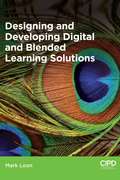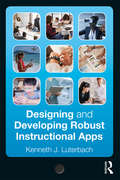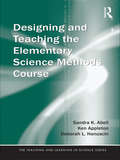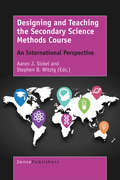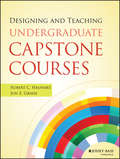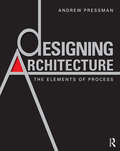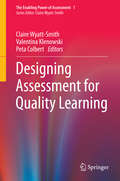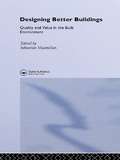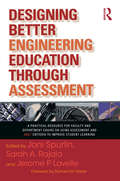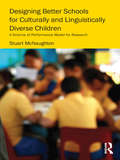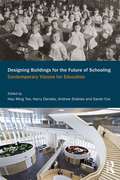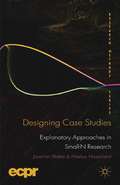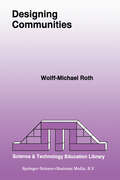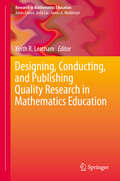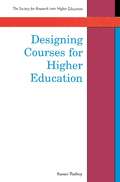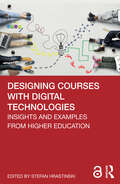- Table View
- List View
Designing and Developing Digital and Blended Learning Solutions
by Mark LoonDesigning and Developing Digital and Blended Learning Solutions is essential reading for anyone studying the Level 5 CIPD L&D module of the same name as well as all learning and development professionals looking to understand the growing role of technology in L&D. Covering both current and emerging learning technologies, this book will help readers assess which technologies are right for their needs. It also covers how to design blended learning solutions, how to develop digital learning content as well as how to evaluate the effectiveness of this digital content. Most importantly, Designing and Developing Digital and Blended Learning Solutions provides guidance on how to implement digital and blended learning solutions including identifying the appropriate platforms and the roles, tools and processes needed to support effective implementation. Full of practical examples and advice, this is an invaluable guide for students and practitioners alike.
Designing and Developing Digital and Blended Learning Solutions
by Mark LoonDesigning and Developing Digital and Blended Learning Solutions is essential reading for anyone studying the Level 5 CIPD L&D module of the same name as well as all learning and development professionals looking to understand the growing role of technology in L&D. Covering both current and emerging learning technologies, this book will help readers assess which technologies are right for their needs. It also covers how to design blended learning solutions, how to develop digital learning content as well as how to evaluate the effectiveness of this digital content. Most importantly, Designing and Developing Digital and Blended Learning Solutions provides guidance on how to implement digital and blended learning solutions including identifying the appropriate platforms and the roles, tools and processes needed to support effective implementation. Full of practical examples and advice, this is an invaluable guide for students and practitioners alike.
Designing and Developing Robust Instructional Apps
by Kenneth J. LuterbachDesigning and Developing Robust Instructional Apps advances the state of instructional app development using three learning paradigms for building knowledge foundations, problem-solving, and experimentation. Drawing on research and development lessons gleaned?from noted educational technologists, time-tested systematic instructional design processes, and results from user experience design, the book considers the planning and specification of instructional apps that blend media (text, images, sound, and moving pictures) and instructional method. Further, for readers with little to no programming experience, introductory treatments of JavaScript and Python, along with data fundamentals and machine learning techniques, offer a guided journey that produces robust instructional apps and?concludes with next steps for advancing the state of instructional app development.
Designing and Developing Robust Instructional Apps
by Kenneth J. LuterbachDesigning and Developing Robust Instructional Apps advances the state of instructional app development using three learning paradigms for building knowledge foundations, problem-solving, and experimentation. Drawing on research and development lessons gleaned?from noted educational technologists, time-tested systematic instructional design processes, and results from user experience design, the book considers the planning and specification of instructional apps that blend media (text, images, sound, and moving pictures) and instructional method. Further, for readers with little to no programming experience, introductory treatments of JavaScript and Python, along with data fundamentals and machine learning techniques, offer a guided journey that produces robust instructional apps and?concludes with next steps for advancing the state of instructional app development.
Designing and Teaching the Elementary Science Methods Course (Teaching and Learning in Science Series)
by Sandra K. Abell Ken Appleton Deborah L. HanuscinWhat do aspiring and practicing elementary science teacher education faculty need to know as they plan and carry out instruction for future elementary science teachers? This scholarly and practical guide for science teacher educators outlines the theory, principles, and strategies needed, and provides classroom examples anchored to those principles. The theoretical and empirical foundations are supported by scholarship in the field, and the practical examples are derived from activities, lessons, and units field-tested in the authors’ elementary science methods courses. Designing and Teaching the Elementary Science Methods Course is grounded in the theoretical framework of pedagogical content knowledge (PCK), which describes how teachers transform subject matter knowledge into viable instruction in their discipline. Chapters on science methods students as learners, the science methods course curriculum, instructional strategies, methods course assessment, and the field experience help readers develop their PCK for teaching prospective elementary science teachers. "Activities that Work" and "Tools for Teaching the Methods Course" provide useful examples for putting this knowledge into action in the elementary science methods course.
Designing and Teaching the Elementary Science Methods Course (Teaching and Learning in Science Series)
by Sandra K. Abell Ken Appleton Deborah L. HanuscinWhat do aspiring and practicing elementary science teacher education faculty need to know as they plan and carry out instruction for future elementary science teachers? This scholarly and practical guide for science teacher educators outlines the theory, principles, and strategies needed, and provides classroom examples anchored to those principles. The theoretical and empirical foundations are supported by scholarship in the field, and the practical examples are derived from activities, lessons, and units field-tested in the authors’ elementary science methods courses. Designing and Teaching the Elementary Science Methods Course is grounded in the theoretical framework of pedagogical content knowledge (PCK), which describes how teachers transform subject matter knowledge into viable instruction in their discipline. Chapters on science methods students as learners, the science methods course curriculum, instructional strategies, methods course assessment, and the field experience help readers develop their PCK for teaching prospective elementary science teachers. "Activities that Work" and "Tools for Teaching the Methods Course" provide useful examples for putting this knowledge into action in the elementary science methods course.
Designing and Teaching the Secondary Science Methods Course: An International Perspective
by Aaron J. Sickel Stephen B. WitzigThe improvement of science education is a common goal worldwide. Countries not only seek to increase the number of individuals pursuing careers in science, but to improve scientific literacy among the general population. As the teacher is one of the greatest influences on student learning, a focus on the preparation of science teachers is essential in achieving these outcomes. A critical component of science teacher education is the methods course, where pedagogy and content coalesce. It is here that future science teachers begin to focus simultaneously on the knowledge, dispositions and skills for teaching secondary science in meaningful and effective ways. This book provides a comparison of secondary science methods courses from teacher education programs all over the world. Each chapter provides detailed descriptions of the national context, course design, teaching strategies, and assessments used within a particular science methods course, and is written by teacher educators who actively research science teacher education. The final chapter provides a synthesis of common themes and unique features across contexts, and offers directions for future research on science methods courses. This book offers a unique combination of ‘behind the scenes’ thinking for secondary science methods course designs along with practical teaching and assessment strategies, and will be a useful resource for teacher educators in a variety of international contexts.
Designing and Teaching Undergraduate Capstone Courses
by Robert C. Hauhart Jon E. GraheEnrich your students and the institution with a high-impact practice Designing and Teaching Undergraduate Capstone Courses is a practical, research-backed guide to creating a course that is valuable for both the student and the school. The book covers the design, administration, and teaching of capstone courses throughout the undergraduate curriculum, guiding departments seeking to add a capstone course, and allowing those who have one to compare it to others in the discipline. The ideas presented in the book are supported by regional and national surveys that help the reader understand what's common, what's exceptional, what works, and what doesn't within capstone courses. The authors also provide additional information specific to different departments across the curriculum, including STEM, social sciences, humanities, fine arts, education, and professional programs. Identified as a high-impact practice by the National Survey of Student Engagement (NSSE) and the Association of American Colleges and Universities' LEAP initiative, capstone courses culminate a student's final college years in a project that integrates and applies what they've learned. The project takes the form of a research paper, a performance, a portfolio, or an exhibit, and is intended to showcase the student's very best work as a graduating senior. This book is a guide to creating for your school or department a capstone course that ties together undergraduate learning in a way that enriches the student and adds value to the college experience. Understand what makes capstone courses valuable for graduating students Discover the factors that make a capstone course effective, and compare existing programs, both within academic disciplines and across institutions Learn administrative and pedagogical techniques that increase the course's success Examine discipline-specific considerations for design, administration, and instruction Capstones are generally offered in departmental programs, but are becoming increasingly common in general education as well. Faculty and administrators looking to add a capstone course or revive an existing one need to understand what constitutes an effective program. Designing and Teaching Undergraduate Capstone Courses provides an easily digested summary of existing research, and offers expert guidance on making your capstone course successful.
Designing and Teaching Undergraduate Capstone Courses
by Robert C. Hauhart Jon E. GraheEnrich your students and the institution with a high-impact practice Designing and Teaching Undergraduate Capstone Courses is a practical, research-backed guide to creating a course that is valuable for both the student and the school. The book covers the design, administration, and teaching of capstone courses throughout the undergraduate curriculum, guiding departments seeking to add a capstone course, and allowing those who have one to compare it to others in the discipline. The ideas presented in the book are supported by regional and national surveys that help the reader understand what's common, what's exceptional, what works, and what doesn't within capstone courses. The authors also provide additional information specific to different departments across the curriculum, including STEM, social sciences, humanities, fine arts, education, and professional programs. Identified as a high-impact practice by the National Survey of Student Engagement (NSSE) and the Association of American Colleges and Universities' LEAP initiative, capstone courses culminate a student's final college years in a project that integrates and applies what they've learned. The project takes the form of a research paper, a performance, a portfolio, or an exhibit, and is intended to showcase the student's very best work as a graduating senior. This book is a guide to creating for your school or department a capstone course that ties together undergraduate learning in a way that enriches the student and adds value to the college experience. Understand what makes capstone courses valuable for graduating students Discover the factors that make a capstone course effective, and compare existing programs, both within academic disciplines and across institutions Learn administrative and pedagogical techniques that increase the course's success Examine discipline-specific considerations for design, administration, and instruction Capstones are generally offered in departmental programs, but are becoming increasingly common in general education as well. Faculty and administrators looking to add a capstone course or revive an existing one need to understand what constitutes an effective program. Designing and Teaching Undergraduate Capstone Courses provides an easily digested summary of existing research, and offers expert guidance on making your capstone course successful.
Designing Architecture: The Elements of Process
by Andrew PressmanDesigning Architecture is an indispensable tool to assist both students and young architects in formulating an idea, transforming it into a building, and making effective design decisions. This book promotes integrative and critical thinking in the preliminary design of buildings to inspire creativity, innovation, and design excellence. This compendium of individual wisdom and collective experience offers explicit guidance to students and young professionals on how to approach, analyze, and execute specific tasks; develop and refine a process to facilitate the best possible design projects; and create meaningful architectural form. Here the design process – from orchestrating client participation to finalizing schematic design – is explored and illuminated. The following material is presented to make the book a useful didactic tool for professional development: explicit strategies for doing design rather than simply reviewing principles and precedents creative ideas in approaching and framing problems in design terms specific methods to translate ideas to culturally significant, socially responsive, and environmentally sensitive buildings techniques to integrate all levels of cognition from analysis to epiphany counsel on developing a personalized process for engaging design projects case studies augment the text and chronicle fascinating applications of the design process. The essence of this book lies in an integrated and holistic approach to each unique project as well as fostering curiosity and exploration – a departure from algorithms, easy generalities, or a formula for design. Designing Architecture will inspire readers to elevate the quality of preliminary designs and unravel some of the mystery of creating the most beautiful, responsive, and responsible architectural design possible.
Designing Architecture: The Elements of Process
by Andrew PressmanDesigning Architecture is an indispensable tool to assist both students and young architects in formulating an idea, transforming it into a building, and making effective design decisions. This book promotes integrative and critical thinking in the preliminary design of buildings to inspire creativity, innovation, and design excellence. This compendium of individual wisdom and collective experience offers explicit guidance to students and young professionals on how to approach, analyze, and execute specific tasks; develop and refine a process to facilitate the best possible design projects; and create meaningful architectural form. Here the design process – from orchestrating client participation to finalizing schematic design – is explored and illuminated. The following material is presented to make the book a useful didactic tool for professional development: explicit strategies for doing design rather than simply reviewing principles and precedents creative ideas in approaching and framing problems in design terms specific methods to translate ideas to culturally significant, socially responsive, and environmentally sensitive buildings techniques to integrate all levels of cognition from analysis to epiphany counsel on developing a personalized process for engaging design projects case studies augment the text and chronicle fascinating applications of the design process. The essence of this book lies in an integrated and holistic approach to each unique project as well as fostering curiosity and exploration – a departure from algorithms, easy generalities, or a formula for design. Designing Architecture will inspire readers to elevate the quality of preliminary designs and unravel some of the mystery of creating the most beautiful, responsive, and responsible architectural design possible.
Designing Assessment for Quality Learning (The Enabling Power of Assessment #1)
by Claire Wyatt-Smith Valentina Klenowski Peta ColbertThis book brings together internationally recognised scholars with an interest in how to use the power of assessment to improve student learning and to engage with accountability priorities at both national and global levels. It includes distinguished writers who have worked together for some two decades to shift the assessment paradigm from a dominant focus on assessment as measurement towards assessment as central to efforts to improve learning. These writers have worked with the teaching profession and, in so doing, have researched and generated key insights into different ways of understanding assessment and its relationship to learning.The volume contributes to the theorising of assessment in contexts characterised by heightened accountability requirements and constant change. The book’s structure and content reflect already significant and growing international interest in assessment as contextualised practice, as well as theories of learning and teaching that underpin and drive particular assessment approaches. Learning theories and practices, assessment literacies, teachers’ responsibilities in assessment, the role of leadership, and assessment futures are the organisers within the book’s structure and content.The contributors to this book have in common the view that quality assessment, and quality learning and teaching are integrally related. Another shared view is that the alignment of assessment with curriculum, teaching and learning is linchpin to efforts to improve both learning opportunities and outcomes for all. Essentially, the book presents new perspectives on the enabling power of assessment. In so doing, the writers recognise that validity and reliability - the traditional canons of assessment – remain foundational and therefore necessary. However, they are not of themselves sufficient for quality education. The book argues that assessment needs to be radically reconsidered in the context of unprecedented societal change. Increasingly, communities are segregating more by wealth, with clear signs of social, political, economic and environmental instability. These changes raise important issues relating to ethics and equity, taken to be core dimensions in enabling the power of assessment to contribute to quality learning for all. This book offers readers new knowledge about how assessment can be used to re/engage learners across all phases of education.
Designing Better Building: Quality And Value In The Built Environment
by Sebastian MacmillanDesign is widely recognised as the key to improving the quality of the built environment. This well-illustrated book comprises 15 chapters written by leading practitioners, clients, academics and other experts, and presents the latest thinking on what design quality is and how to achieve it. For design practitioners and their clients alike, the book provides evidence to justify greater focus on, and investment in, design. It summarises the benefits that arise from good design - such as, civic pride in the urban environment, the stimulation of urban regeneration, corporate identity, occupant productivity and health in offices, improved learning outcomes in schools, better patient recovery rates in hospitals, as well as reduced environmental impact. And it illustrates these benefits through case study examples. Eight chapters focus on case studies of exemplary buildings in particular sectors - offices, schools, housing, and hospitals - and explain why and how they came to be designed, and the design qualities they exhibit.
Designing Better Building
by Sebastian MacmillanDesign is widely recognised as the key to improving the quality of the built environment. This well-illustrated book comprises 15 chapters written by leading practitioners, clients, academics and other experts, and presents the latest thinking on what design quality is and how to achieve it. For design practitioners and their clients alike, the book provides evidence to justify greater focus on, and investment in, design. It summarises the benefits that arise from good design - such as, civic pride in the urban environment, the stimulation of urban regeneration, corporate identity, occupant productivity and health in offices, improved learning outcomes in schools, better patient recovery rates in hospitals, as well as reduced environmental impact. And it illustrates these benefits through case study examples. Eight chapters focus on case studies of exemplary buildings in particular sectors - offices, schools, housing, and hospitals - and explain why and how they came to be designed, and the design qualities they exhibit.
Designing Better Engineering Education Through Assessment: A Practical Resource for Faculty and Department Chairs on Using Assessment and ABET Criteria to Improve Student Learning
by Richard M. Felder Joni E. Spurlin Sarah A. Rajala Jerome P. LavelleThis book is written for engineering faculty and department chairs as a practical guide to improving the assessment processes for undergraduate and graduate engineering education in the service of improved student learning. It is written by engineering faculty and assessment professionals who have many years of experience in assessment of engineering education and of working with engineering faculty. The book reflects the emphasis placed on student outcomes assessment by ABET, Inc., the organization that accredits most U.S. engineering, computer science and technology programs, as well as providing substantial equivalency evaluations to international engineering programs. The book begins with a brief overview of assessment theory and introduces readers to key assessment resources. It illustrates–through practical examples that reflect a wide range of engineering disciplines and practices at both large and small institutions, and along the continuum of students’ experience, from first year to capstone engineering courses through to the dissertation–how to go about applying formative and summative assessment practices to improve student learning at the course and program levels. For most institutions, assessment of graduate education is new; therefore, there are readers who will be particularly interested in the chapters and examples related to graduate education. This book concludes with a vision for the future of assessment for engineering education. The authors cover five basic themes:· Use of assessment to improve student learning and educational programs at both undergraduate and graduate levels· Understanding and applying ABET criteria to accomplish differing program and institutional missions· Illustration of evaluation/assessment activities that can assist faculty in improving undergraduate and graduate courses and programs· Description of tools and methods that have been demonstrated to improve the quality of degree programs and maintain accreditation· Identification of methods for overcoming institutional barriers and challenges to implementing assessment initiatives.
Designing Better Engineering Education Through Assessment: A Practical Resource for Faculty and Department Chairs on Using Assessment and ABET Criteria to Improve Student Learning
This book is written for engineering faculty and department chairs as a practical guide to improving the assessment processes for undergraduate and graduate engineering education in the service of improved student learning. It is written by engineering faculty and assessment professionals who have many years of experience in assessment of engineering education and of working with engineering faculty. The book reflects the emphasis placed on student outcomes assessment by ABET, Inc., the organization that accredits most U.S. engineering, computer science and technology programs, as well as providing substantial equivalency evaluations to international engineering programs. The book begins with a brief overview of assessment theory and introduces readers to key assessment resources. It illustrates–through practical examples that reflect a wide range of engineering disciplines and practices at both large and small institutions, and along the continuum of students’ experience, from first year to capstone engineering courses through to the dissertation–how to go about applying formative and summative assessment practices to improve student learning at the course and program levels. For most institutions, assessment of graduate education is new; therefore, there are readers who will be particularly interested in the chapters and examples related to graduate education. This book concludes with a vision for the future of assessment for engineering education. The authors cover five basic themes:· Use of assessment to improve student learning and educational programs at both undergraduate and graduate levels· Understanding and applying ABET criteria to accomplish differing program and institutional missions· Illustration of evaluation/assessment activities that can assist faculty in improving undergraduate and graduate courses and programs· Description of tools and methods that have been demonstrated to improve the quality of degree programs and maintain accreditation· Identification of methods for overcoming institutional barriers and challenges to implementing assessment initiatives.
Designing Better Schools for Culturally and Linguistically Diverse Children: A Science of Performance Model for Research
by Stuart McNaughtonHow can schools be better designed to enable equitable academic outcomes for culturally and linguistically diverse children from communities lacking in economic, political and social power? Putting forward a robust ‘science of performance’ model of school change based on a specified process of research and development in local contexts, this book: lays out the traditions of optimism and pessimism about effective schooling for at-risk students reviews the international and national evidence for the effectiveness of schools and school systems in reducing disparities in achievement describes the challenges educational research must address to solve the problem of school effectiveness, proposes strict criteria against which effectiveness should be judged, and examines in detail examples where change has been demonstrated proposes how researchers, professionals, and policy-makers can develop more effective systems. Bringing together structural and psychological accounts of the nature of schools, and establishing theoretically defensible criteria for judging effectiveness, this book is a critically important contribution to advancing the science of making schools more effective.
Designing Better Schools for Culturally and Linguistically Diverse Children: A Science of Performance Model for Research
by Stuart McNaughtonHow can schools be better designed to enable equitable academic outcomes for culturally and linguistically diverse children from communities lacking in economic, political and social power? Putting forward a robust ‘science of performance’ model of school change based on a specified process of research and development in local contexts, this book: lays out the traditions of optimism and pessimism about effective schooling for at-risk students reviews the international and national evidence for the effectiveness of schools and school systems in reducing disparities in achievement describes the challenges educational research must address to solve the problem of school effectiveness, proposes strict criteria against which effectiveness should be judged, and examines in detail examples where change has been demonstrated proposes how researchers, professionals, and policy-makers can develop more effective systems. Bringing together structural and psychological accounts of the nature of schools, and establishing theoretically defensible criteria for judging effectiveness, this book is a critically important contribution to advancing the science of making schools more effective.
Designing Buildings for the Future of Schooling: Contemporary Visions for Education
by Hau Ming Tse Harry Daniels Andrew Stables Sarah CoxBringing together leading experts from the fields of architecture, design, engineering, education and the social sciences, this valuable collection presents a multidimensional understanding of the complexities and ways in which school designs influence and are influenced by educational practice. Moving beyond the long-debated question as to whether the design of a school influences pedagogic practice, chapters acknowledge the multiple and diverse ways in which teaching, learning, development and inclusion are impacted by the nature and quality of the physical environment. Considering changes in national and international policy, and exploring the changing pressures and demands on design, education and schooling more broadly, contributors rethink and re-envision those aspects of design and educational practice in which they specialise. Together, these chapters present a bold vision for the future conceptualisation, development and use of school buildings and facilities. An important contribution to debates on school design and education, inclusion and pedagogy, this is an essential and fascinating read for students, researchers, lecturers and policymakers involved in the fields of education and architecture.
Designing Buildings for the Future of Schooling: Contemporary Visions for Education
by Hau Ming Tse Harry Daniels Andrew Stables Sarah CoxBringing together leading experts from the fields of architecture, design, engineering, education and the social sciences, this valuable collection presents a multidimensional understanding of the complexities and ways in which school designs influence and are influenced by educational practice. Moving beyond the long-debated question as to whether the design of a school influences pedagogic practice, chapters acknowledge the multiple and diverse ways in which teaching, learning, development and inclusion are impacted by the nature and quality of the physical environment. Considering changes in national and international policy, and exploring the changing pressures and demands on design, education and schooling more broadly, contributors rethink and re-envision those aspects of design and educational practice in which they specialise. Together, these chapters present a bold vision for the future conceptualisation, development and use of school buildings and facilities. An important contribution to debates on school design and education, inclusion and pedagogy, this is an essential and fascinating read for students, researchers, lecturers and policymakers involved in the fields of education and architecture.
Designing Case Studies: Explanatory Approaches in Small-N Research (ECPR Research Methods)
by J. Blatter M. HaverlandThe authors explore three ways of conducting causal analysis in case studies. They draw on established practices as well as on recent innovations in case study methodology and integrate these insights into coherent approaches. They highlight the core features of each approach and provide advice on each step of the research process.
Designing Communities (Contemporary Trends and Issues in Science Education #3)
by Wolff-Michael RothThe study described in this book arose in the contextof a three-year collective effort to bring about change in science teaching at Mountain Elementary School. 1 This opportunity emerged after I contacted the school with the idea to help teachers implement student-centered science teaching. At the same time, the teachers collectively had come to realize that their science teaching was not as exciting to children as it could be. They had recognized their own teaching as textbook-based with little use of the "hands-on" approaches prescribed by the provincial curriculum. At this point, the teachers and I decided that a joint project would serve our mutual goals: they wanted assistance in changing from textbook-based approaches to student-centered activities; I wanted to collect data on learning in student-centered knowledge producing classroom communities. I brought to this school my new understandings about classroom communi ties from several earlier studies conducted in a private high school (e. g. , Roth & Bowen, 1995; Roth & Roychoudhury, 1992). I wanted to help teachers create science learning environments in which children took charge of their learning, where children learned from more competent others by participating with them in ongoing activities, and teachers were responsible for setting up and maintaining a classroom community rather than for dissem inating information. After I had completed the data collection for the present study, I watched a documentary about an elementary school in the small French village of Moussac (Envoye Special, TV5, September 14, 1994).
Designing, Conducting, and Publishing Quality Research in Mathematics Education (Research in Mathematics Education)
by Keith R. LeathamThe purpose of this book is to collect, organize and disseminate collective wisdom with respect to designing, conducting, and publishing quality research in mathematics education. This wisdom will be gleaned from among those who, over the past several decades, have been instrumental in guiding the field in the pursuit of excellence in mathematics education research—insightful editors, educative reviewers, prolific writers, and caring mentors. Each chapter is written to the novice researcher with the intent of aiding them in avoiding common pitfalls, navigating difficult intellectual terrain, and understanding that they are not alone in experiencing rejection, frustration, confusion, and doubt. This book differs from existing literature in the sense that it is written about the enterprise of designing, conducting and publishing research in mathematics education as opposed to being reports of the results of such work. It also differs in the sense that it is written with the intent to mentor the rising generation as opposed to capture the state of the field (as would happen in a handbook, for example). It is written for the express purpose of helping the field work collectively to aid in the often isolated enterprise of mentoring new researchers. The primary audience is a potentially wide one: graduate students, novice researchers, graduate faculty, advisors, and mentors – or anyone seeking to improve their own abilities to design, conduct, and publish quality research in mathematics education.
Designing Courses for Higher Education (UK Higher Education OUP Humanities & Social Sciences Higher Education OUP)
by Susan TooheyWhat issues need to be considered in designing a course or unit of study in higher education?Who should be involved in designing a course, and how can they best work together?What should students get out of a course?Susan Toohey focuses not on teaching techniques but on the strategic decisions which must be made before a course begins. She provides realistic advice for university and college teachers on how to design more effective courses without underestimating the complexity of the task facing course developers. In particular, she examines fully the challenges involved in leading course design teams, getting agreement among teaching staff and managing organizational politics. She also explores the key role played by academics' own values and beliefs (often unexamined) in shaping course design and student experience. In doing so, she offers course designers both an understanding and a framework within which to clarify their own teaching purposes.Designing Courses for Higher Education is an accessible, jargon free text, providing practical assistance and enlivened by many examples of innovative practice and interviews with academics involved in course design. It is a key resource for college and university teachers.
Designing Courses with Digital Technologies: Insights and Examples from Higher Education
by Stefan HrastinskiDesigning Courses with Digital Technologies offers guidance for higher education instructors integrating digital technologies into their teaching, assessment and overall support of students. Written by and for instructors from a variety of disciplines, this book presents evaluations that the contributors have implemented in real-life courses, spanning blended and distance learning, flipped classrooms, collaborative technologies, video-supported learning and beyond. Chapter authors contextualize their approaches beyond simple how-tos, exploring both the research foundations and professional experiences that have informed their use of digital tools while reflecting on their successes, challenges and ideas for future development.
